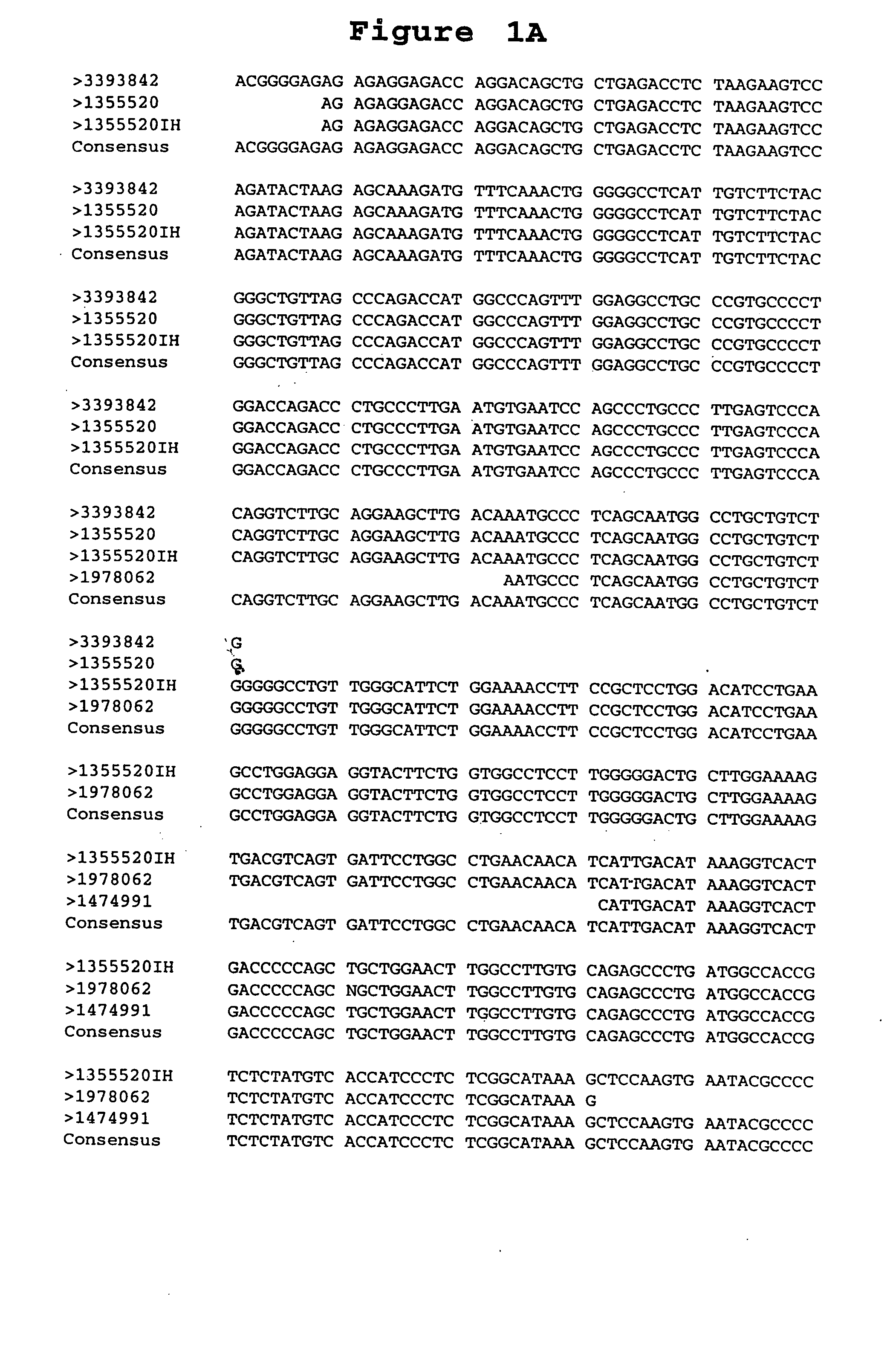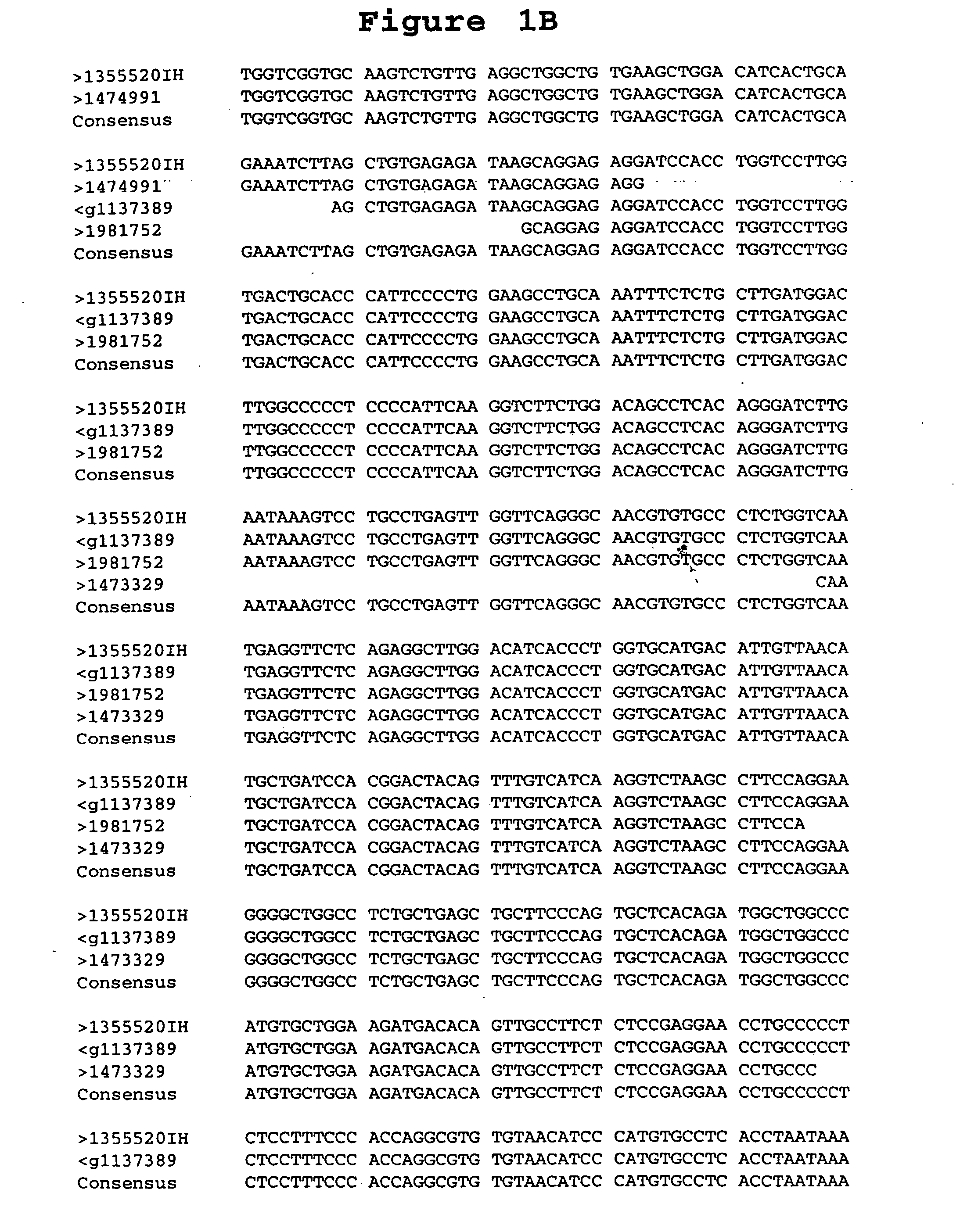Reagents and methods useful for detecting diseases of the lung
a technology of reagents and methods, applied in the field of lung diseases detection, can solve the problems of limiting the sensitivity of chest radiographs, insufficient sensitivity of routine procedures, so as to avoid denaturation or irreversible adsorption of samples, and maintain the integrity of specimens
- Summary
- Abstract
- Description
- Claims
- Application Information
AI Technical Summary
Benefits of technology
Problems solved by technology
Method used
Image
Examples
example 1
Identification of Lung Tissue Library LS170 Gene-Specific Clones
[0197] A. Library Comparison of Expressed Sequence Tags (EST's) or Transcript Images. Partial sequences of cDNA clone inserts, so-called “expressed sequence tags” (EST's), were derived from cDNA libraries made from lung tumor tissues, lung non-tumor tissues, and numerous other tissues, both tumor and non-tumor, and entered into a database (LIFESEQ™ database, available from Incyte Pharmaceuticals, Palo Alto, Calif.) as gene transcript images. See International Publication No. WO 95 / 20681. (A transcript image is a listing of the number of EST's for each of the represented genes in a given tissue library. EST's sharing regions of mutual sequence overlap are classified into clusters. A cluster is assigned a clone number from a representative 5′ EST. Often, a cluster of interest can be extended by comparing its consensus sequence with sequences of other EST's which did not meet the criteria for automated clustering. The ali...
example 2
Sequencing of LS170 EST-Specific Clones
[0199] The full-length DNA sequence of clone 1355520 (clone 1355520IH, SEQUENCE ID NO 8), which is an EST near the 5′-end of the LS170 gene contig, was determined using dideoxy termination sequencing with dye terminators following known methods. See, e.g., F. Sanger et al., PNAS U.S.A. 74: 5463 (1977).
[0200] Because the pINCY vector (Life Technologies, Gaithersburg, Md.) contains universal priming sites just adjacent to the 3′ and 5′ ligation junctions of the inserts, approximately 300 bases of the insert were sequenced in both directions using two universal primers (SEQUENCE ID NO 12 and SEQUENCE ID NO 13, available from New England Biolabs, Beverly, Mass., and Applied Biosystems Inc, Foster City, Calif., respectively). The sequencing reactions were run on a polyacrylamide denaturing gel, and the sequences were determined by an Applied Biosystems 377 Sequencer (available from Applied Biosystems, Foster City, Calif.) or other sequencing appar...
example 3
[0201] A. RNA Extraction from Tissue. Total RNA was isolated from lung tissues and from non-lung tissues. Various methods were utilized, including but not limited to the lithium chloride / urea technique, known in the art and described by Kato et al. (J. Virol. 61: 2182-2191, 1987), and TRIzol™ (Gibco-BRL, Grand Island, N.Y.).
[0202] Briefly, tissue was placed in a sterile conical tube on ice and 10-15 volumes of 3 M LiCl, 6 M urea, 5 mM EDTA, 0.1 M β-mercaptoethanol, 50 mM Tris-HCl (pH 7.5) were added. The tissue was homogenized with a Polytron® homogenizer (Brinkman Instruments, Inc., Westbury, N.Y.) for 30-50 sec on ice. The solution was transferred to a 15 ml plastic centrifuge tube and placed overnight at −20° C. The tube was centrifuged for 90 min at 9,000×g at 0-4° C. and the supernatant was immediately decanted. Ten ml of 3 M LiCl were added and the tube was vortexed for 5 sec. The tube was centrifuged for 45 min at 11,000×g at 0-4° C. The decanting, resuspension ...
PUM
| Property | Measurement | Unit |
|---|---|---|
| Fraction | aaaaa | aaaaa |
Abstract
Description
Claims
Application Information
 Login to View More
Login to View More - R&D
- Intellectual Property
- Life Sciences
- Materials
- Tech Scout
- Unparalleled Data Quality
- Higher Quality Content
- 60% Fewer Hallucinations
Browse by: Latest US Patents, China's latest patents, Technical Efficacy Thesaurus, Application Domain, Technology Topic, Popular Technical Reports.
© 2025 PatSnap. All rights reserved.Legal|Privacy policy|Modern Slavery Act Transparency Statement|Sitemap|About US| Contact US: help@patsnap.com



